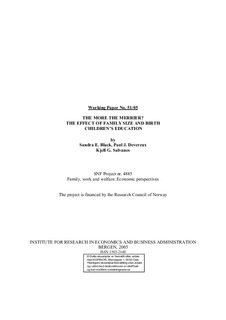| dc.description.abstract | There is an extensive theoretical literature that postulates a tradeoff between child quantity and quality within a family. However, there is little causal evidence that speaks to this theory. Using a rich dataset on the entire population of Norway over an extended period of time, we examine the effects of family size and birth order on the educational attainment of children. While we find a negative correlation between family size and children’s education, when we include indicators for birth order and/or use twin births as an instrument, family size effects become negligible. In addition, birth order has a significant and large negative effect on children’s education. We also study adult earnings, employment, and teenage childbearing, and find strong evidence for birth order effects with these outcomes, particularly among women. These findings suggest the need to revisit economic models of fertility and child “production”, focusing not only on differences across families but differences within families as well. | en |
